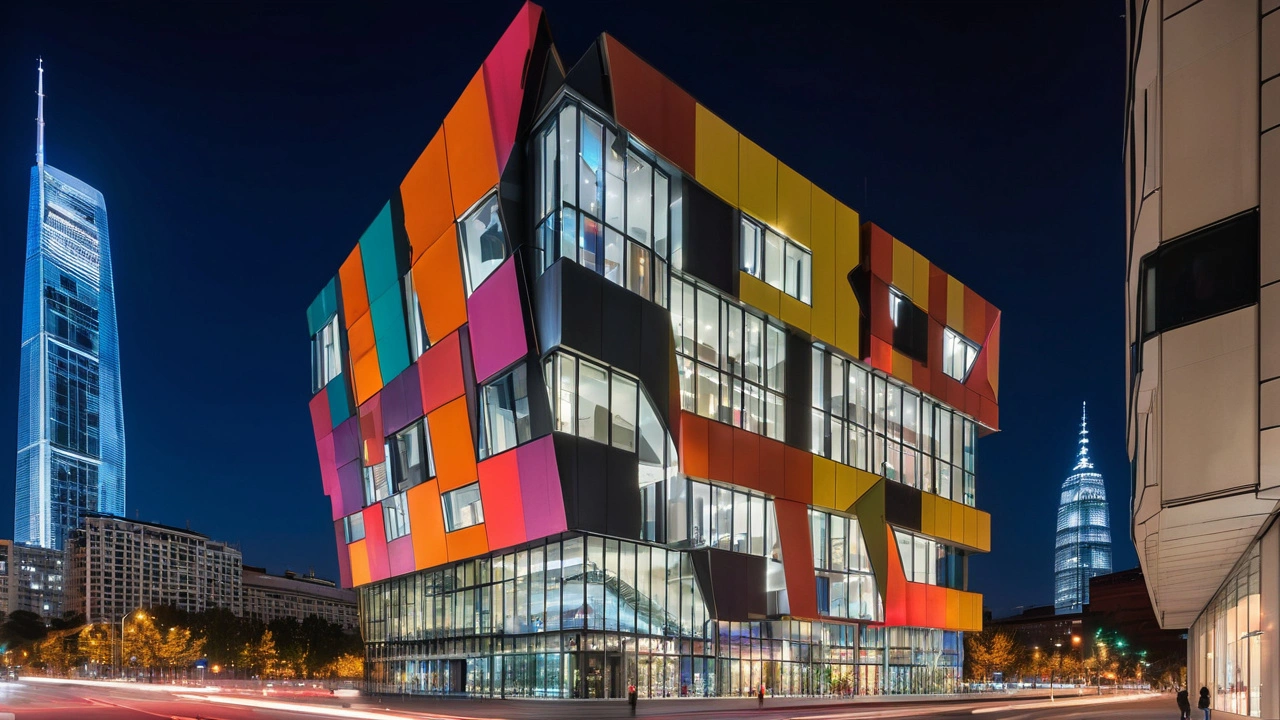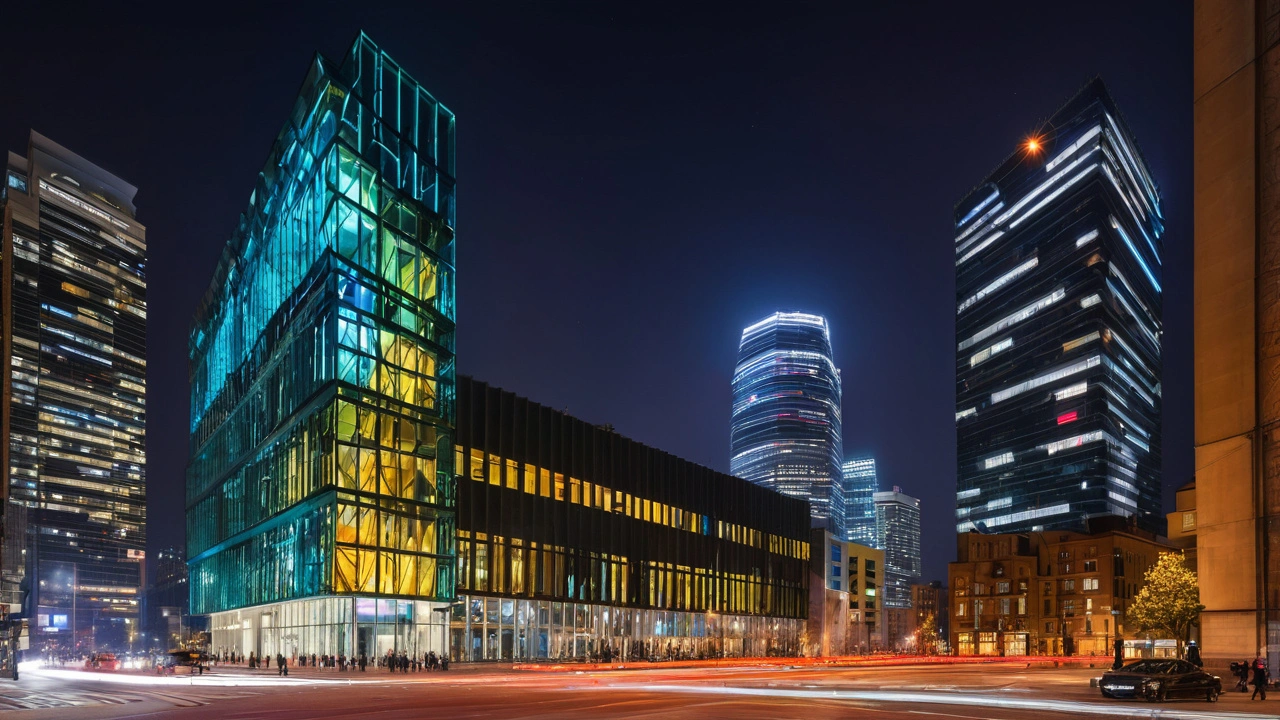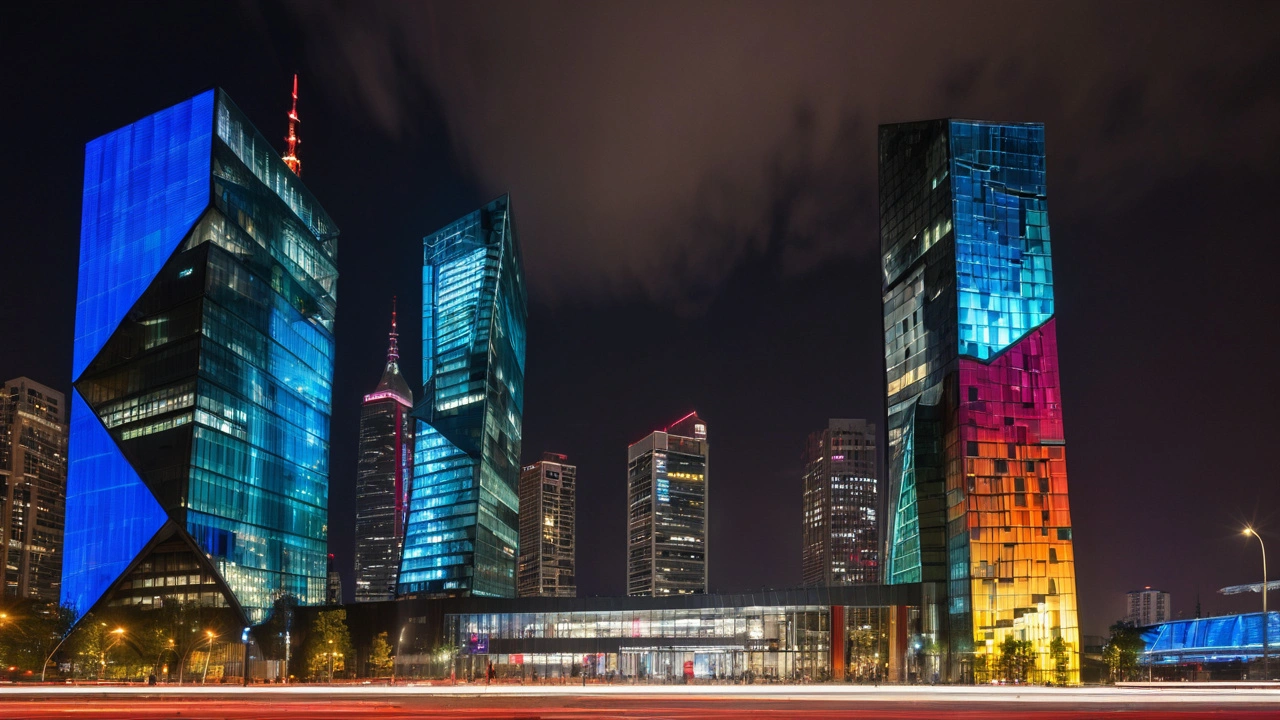The Story and Influence of Deconstructivism in Architecture
 Jul, 23 2024
Jul, 23 2024
Deconstructivism burst onto the architectural scene in the late 20th century, shattering long-held conventions with its bold and fragmented designs. Unlike other movements that sought harmony and order, deconstructivist architecture embraces chaos and disarray.
The term 'deconstructivism' itself hints at its roots in the philosophical ideas of deconstruction, which question binary oppositions and fixed meanings. This philosophy became a jumping-off point for architects eager to explore new forms and ideas through their work.
Some of the most recognizable structures of the modern era are products of this movement, crafted by visionary architects who turned traditional boundaries on their head. We'll delve into how deconstructivism evolved, its key players, and its lasting impact on the world of architecture.
- Origins and Definition
- Philosophical Influences
- Key Architects and Projects
- Impact on Modern Architecture
- Deconstructivism and Sustainability
- Future of Deconstructivism
Origins and Definition
Deconstructivism emerged as an antidote to the rigid and predictable architectural styles that dominated the 20th century. This movement gained traction during the late 1980s, primarily during a groundbreaking exhibition at the Museum of Modern Art in New York City, aptly titled “Deconstructivist Architecture”. Curated by Philip Johnson and Mark Wigley, the exhibition was a watershed moment for architects seeking new forms of expression.
The term deconstructivism stems from the philosophical theory of deconstruction, which was developed by French philosopher Jacques Derrida in the 1960s. This theory questions accepted ideals, breaks down traditional binaries, and delves into layers of meaning in texts and concepts. In architecture, this translates into creations that defy cohesion and symmetry in favor of fragmented forms and unexpected angles. Buildings influenced by deconstructivism are meant to challenge, provoke, and surprise.
Deconstructivist architecture forms structures that are disjointed and chaotic, modeling an unpredictable harmony. This is architecture where right angles and grid formation are mere suggestions.
One of the earlier influences on deconstructivism was the Russian Constructivist movement from the early 20th century, known for its experimental approach and utopian vision. However, deconstructivist architects went a step further by embracing disarray and the concept of accident over precision. This was a revolt not just against traditional architectural aesthetics but also against modernism and its emphasis on functionality and simplicity.
Some of the most notable architects associated with deconstructivism include the likes of Frank Gehry, Zaha Hadid, and Peter Eisenman. Frank Gehry's iconic Guggenheim Museum in Bilbao, with its flowing, twisting lines, stands as a testament to the deconstructivist ethos. Zaha Hadid, known for her futuristic and fluid forms, pushed the boundaries of what buildings could look like. Peter Eisenman, often philosophically grounded in Derrida’s deconstruction, created works that were intellectually stimulating and visually arresting.
Deconstructivism didn’t confine itself merely to aesthetics. Many practitioners embedded deeper philosophical and political statements into their designs. These structures often seem to be in flux, reflecting the ever-changing nature of society and thought. This nonconformity challenged not just the architectural norms but also the viewers' perceptions and expectations.
The rise of deconstructivist architecture led to debates and discussions across the architectural community. While some hailed it as a liberating movement that brought fresh creativity, others criticized it for being overly complex and impractical. Despite these debates, the influence of deconstructivism on the architectural landscape cannot be denied. It paved the way for more experimental and daring designs in the years that followed.
Philosophical Influences
Deconstructivism isn't just a random rebellion against architectural order; it's deeply rooted in the philosophical ideas of deconstruction, a concept popularized by the French philosopher Jacques Derrida. Derrida's ideas challenged traditional notions of meaning and structure, promoting the idea that meanings are unstable and that structures can be broken down to reveal multiple interpretations. This approach resonated with architects who were eager to push the boundaries of form and function.
One core tenant of deconstruction is the belief that binary oppositions—such as order and chaos—are not as clear-cut as they seem. Instead, they interrelate in ways that can be visually represented through architecture. This idea encouraged architects to explore asymmetry, fragmentation, and non-linear processes, resulting in buildings that appear dynamic and unpredictable. Such designs question the very nature of what a building should be.
The influence of Derrida is most evident in the work of Peter Eisenman, one of the early proponents of deconstructivist architecture. Eisenman openly acknowledged Derrida's impact on his thinking. He attempted to translate philosophical questions into physical spaces, creating what can be described as 'architectural essays.' His works, like the Wexner Center for the Arts in Ohio, embody the principles of deconstruction with their tilted grids and fractured forms.
Another key figure is architect Bernard Tschumi, whose work often questions the relationships between spaces and their uses. Tschumi has been quoted as saying, 'Disjunction becomes the basis for harmony.' This reflects a core tenet of deconstructivism: the idea that harmony can be found in discord. His Parc de la Villette in Paris showcases an assortment of unrelated elements that somehow achieve a cohesive, if not jarring, unity.
However, it's not just philosophers and architects who contributed to this movement. Artists and writers, such as Russian Constructivists and even literature from postmodern authors, provided a fertile ground of ideas. The multidisciplinary influence helped in forming a distinctive style that refuses to be categorized neatly.
Interesting enough, some might argue that deconstructivism has parallels in other fields beyond architecture. For instance, in literature, the works of James Joyce and his fragmented narratives mirror the visual disruption seen in deconstructivist buildings. This cross-disciplinary impact highlights the movement's broad philosophical scope and its intent to question and redefine boundaries across various forms of art and knowledge.
Deconstructivism, philosophically speaking, is a lens through which we can view the complexities and contradictions of the modern world. It encourages us to embrace uncertainty and complexity rather than shying away from them. By doing so, both philosophers and architects alike have opened up a realm of endless possibilities, crafting environments that challenge and inspire us to think differently.

Key Architects and Projects
When it comes to deconstructivism in architecture, a few names stand out for their bold visions and ability to translate chaotic concepts into stunning physical structures. One of the most iconic figures is Frank Gehry. Renowned for his unique approach to building designs, Gehry's work often looks like it's just sprung to life from a sketch, full of energy and movement. His Guggenheim Museum in Bilbao, Spain, opened in 1997, is a marvel of modern design. The museum's striking curves and metallic cladding have turned it into a symbol of H's architectural prowess and the transformative power of deconstructivism. Many credit the Guggenheim with revitalizing the city of Bilbao, illustrating how innovative architecture can have far-reaching impacts on urban renewal.
Another pivotal figure is Zaha Hadid, often dubbed the 'Queen of the Curve.' Her designs are characterized by fluid forms and dynamic geometries. One of her standout projects is the Heydar Aliyev Center in Baku, Azerbaijan. This building’s swooping forms and smooth finishes make it a prime example of deconstructivist ideas brought to life. “I have always believed in experimentation and using innovative technologies for creating meaningful, exciting, and attractive spaces,” Hadid once said.
Also notable is Daniel Libeskind, whose work often reflects a narrative quality, tying deeply into history and memory. His Jewish Museum in Berlin offers a poignant exploration of the Jewish history in Germany. The museum’s fragmented form and jagged lines echo the tumultuous experiences of the Jewish community, making it not just a building but a living story. Libeskind’s approach demonstrates the power of architecture to communicate complex and emotional narratives.
Beyond these iconic figures, there are newer voices contributing to the deconstructivist movement. Architects like Rem Koolhaas of OMA (Office for Metropolitan Architecture) push boundaries with projects that challenge traditional interpretations of space. His CCTV Headquarters in Beijing looks like a looped string, defying the standard skyscraper form. The building's form not only makes a visual statement but also reimagines how office spaces can be structured, emphasizing the deconstructivist theme of breaking away from norms.
Of course, the influence of Deconstructivism isn’t limited to these marquee projects. From smaller cultural institutions to daring residential designs, architects across the globe are incorporating these ideas to great effect. The Vitamine T building in France by architect Bernard Tschumi demonstrates this. Tschumi, who also designed the Parc de la Villette in Paris, showcases how deconstructivist principles can be used to shape a wide variety of spaces, infusing everyday environments with a sense of curiosity and wonder.
In summary, the deconstructivist movement has unleashed new ways to think about and approach architecture. This relentless curiosity and desire to push boundaries have produced some of the most memorable and impactful buildings of the modern era. As architecture continues to evolve, the foundational work laid by these pioneering architects provides inspiration and a roadmap for future innovation.
Impact on Modern Architecture
Deconstructivism, with its bold and often fragmented designs, has left a significant mark on modern architecture. Architects who embraced this movement didn't just build structures; they crafted experiences that challenge our perceptions of form and space. One can see the influence of deconstructivism in numerous contemporary buildings that feature unexpected angles, irregular shapes, and a breaking away from the linearity typical of traditional design.
A key element of this impact is the way deconstructivism opened up new possibilities for materials and construction techniques. The Guggenheim Museum in Bilbao, designed by Frank Gehry, is a perfect example. Clad in titanium, this building's twisting forms and reflective surfaces couldn’t have been achieved without cutting-edge technology. Gehry’s work illustrates how deconstructivism has pushed the boundaries of what is architecturally possible.
Moreover, deconstructivism has influenced the cultural role of architecture. By creating buildings that are often visually disruptive, it prompts people to engage with architectural spaces in ways they might not have previously considered. This interaction is especially evident in public buildings and museums, where architects deliberately design spaces to evoke thought and conversation. Daniel Libeskind’s Jewish Museum in Berlin is a remarkable instance of this; its jagged form and use of voids and slanted walls create a powerful narrative on the history it represents.
One of the often-cited benefits of deconstructivism is its ability to symbolize complex social and cultural narratives. Linda N. Groat, an architectural theorist, notes that “deconstructivist architecture enables designers to explore and express multifaceted identities and historical intricacies in built form.” This approach has given rise to many structures that are not just buildings, but iconic statements reflective of their times and places.
However, this movement has its critics. Some argue that prioritizing aesthetics and form over functionality can lead to impractical and inefficient buildings. These critiques underscore a tension that continues to shape the discourse on modern architecture: the balance between innovation and usability. Deconstructivism unapologetically tips this balance toward innovation, often at the cost of conventional utility.
Another point of influence is in the realm of digital architecture. The fluid, fragmented forms of deconstructivism have become more achievable with advancements in computer-aided design (CAD) software. What once seemed technologically unfeasible can now be designed and constructed with relative ease. For instance, the Beijing National Stadium, or 'Bird’s Nest,' designed by Herzog & de Meuron, leverages complex structures and entwining forms made possible through digital design techniques.
The impact of deconstructivism on modern architecture is also evident in its contribution to sustainability. While the movement itself does not inherently focus on sustainable design, the innovative use of materials and construction techniques born from deconstructivist principles have inadvertently paved the way for more energy-efficient buildings. For example, irregular facades can be utilized to optimize natural light and ventilation, reducing reliance on artificial climate control systems.
Among the most influential effects of deconstructivism is its role in encouraging architects to think outside the norms. By breaking away from traditional design principles, architects are inspired to approach problems creatively and inventively. This willingness to innovate is not confined to those who identify strictly with deconstructivism but resonates throughout the broader architectural community, encouraging a spirit of experimentation and forward-thinking.
In short, the impact of deconstructivism on modern architecture is broad and multifaceted, touching everything from materials and methods to the cultural significance of buildings. It continues to inspire both admiration and debate, challenging architects and the public alike to consider what architecture can do beyond merely providing shelter.

Deconstructivism and Sustainability
Deconstructivism, known for its chaotic and fragmented shapes, seems at odds with the idea of sustainability. At first glance, it's easy to assume that the movement's focus on unconventional forms would complicate environmentally-friendly building practices. However, many architects within this style have successfully integrated sustainable design principles.
One way deconstructivist architects achieve sustainability is by using materials that are eco-friendly or recycled. Frank Gehry, a notable figure in the movement, often incorporates materials that would otherwise be considered waste. For example, in his design for the Walt Disney Concert Hall, Gehry used stainless steel panels that are both durable and recyclable. This not only reduces waste but also requires less maintenance over time, which is a sustainable practice in itself.
Another approach to marrying deconstructivism with sustainability lies in the building techniques employed. Advanced technologies and construction methods can reduce the environmental footprint of a project. For instance, Computer-Aided Design (CAD) allows architects to precisely calculate the amount of materials needed, minimizing excess and reducing waste. This precision is particularly important in deconstructivist structures, where complex and non-linear designs can otherwise lead to inefficiencies.
A noteworthy project that showcases this blend is the Vitra Design Museum by Frank Gehry. In its construction, Gehry utilized timber frames, which are not only sustainable but also provide a unique aesthetic. Green roofs and rainwater harvesting systems further contribute to the building's sustainability, illustrating how deconstructivist design can be aligned with eco-friendly practices.
“Green architecture and deconstructivism can go hand in hand. The challenge is to blend innovation with responsibility,” notes architect Zaha Hadid.
Energy efficiency is another crucial aspect. Deconstructivist buildings often feature large, irregular windows that let in ample natural light, reducing the need for artificial lighting. Innovative ventilation systems and smart glass can also help in maintaining energy efficiency and reducing the building's carbon footprint.
Moreover, urban planners and architects in the deconstructivist movement are rethinking how buildings interact with their surroundings. By considering factors like a structure's orientation, land use, and the local climate, they are able to design buildings that naturally conserve energy. This holistic approach not only enhances the building’s sustainability but also improves its functionality and user experience.
Incorporating the principles of deconstructivism with sustainable architecture may seem like a Herculean task. Yet, the innovative mindset that defines deconstructivism is well-suited to tackling the complexities of eco-friendly design. By re-imagining materials, construction techniques, and the ways buildings interact with their environment, architects are showing that sustainable deconstructivism is not only possible but also an exciting frontier in modern architecture.
Indeed, the unpredictable and radical forms of deconstructivism provide a unique platform to explore and push the boundaries of sustainability. As architects continue to innovate within this movement, they are proving that even the most avant-garde designs can adhere to and advance sustainable practices. This not only ensures a lesser environmental impact but also paves the way for future developments that are both visually striking and environmentally responsible.
Future of Deconstructivism
As we peer into the future of deconstructivism, it is clear that this architectural movement will continue to evolve and inspire. Advances in technology and materials provide new opportunities for architects to push boundaries even further. Today's architects can use complex algorithms and cutting-edge software to create designs that were once impossible. These digital tools not only allow for greater precision but also offer a canvas for virtually limitless creativity.
The role of sustainability in architecture cannot be ignored, and deconstructivism is no exception. There is a growing trend among architects to integrate sustainable practices within deconstructivist frameworks. This means using eco-friendly materials, energy-efficient systems, and innovative construction techniques to reduce the environmental impact. Such practices ensure that the bold aesthetics of deconstructivism do not come at the expense of the planet.
A notable trend in the future of deconstructivism is the fusion of art and architecture. Architects are increasingly collaborating with artists to create multi-disciplinary spaces that serve as functional works of art. This melding of disciplines promises to yield unique and engaging structures that challenge traditional notions of space and design.
"Architecture should speak of its time and place, but yearn for timelessness." - Frank Gehry
One cannot discuss the future without acknowledging the potential impact of artificial intelligence and machine learning. These technologies are poised to revolutionize the way architects conceptualize and execute their designs. By analyzing vast amounts of data, AI can offer insights into structural integrity, material efficiency, and aesthetic possibilities. This ensures that the bold, fragmented aesthetics of deconstructivism are grounded in practicality and innovation.
In educational settings, there is a shift towards embracing more experimental and interdisciplinary approaches. Architecture schools around the world are incorporating courses that encourage students to explore deconstructivist principles within their designs. This focus on experimentation ensures that the next generation of architects will continue to push the creative envelope.
Community engagement is another critical aspect shaping the future of deconstructivism. Architects are increasingly involving community members in the design process to ensure that the resulting structures are not only visually striking but also culturally relevant and inclusive. This collaborative approach helps to create spaces that resonate with the people who use them.
Ultimately, the future of deconstructivism looks bright. As architects continue to embrace new technologies, sustainable practices, and collaborative processes, this movement will undoubtedly chart new territories. With its commitment to challenging norms and exploring new possibilities, deconstructivism stands poised to shape the architectural landscape for years to come.